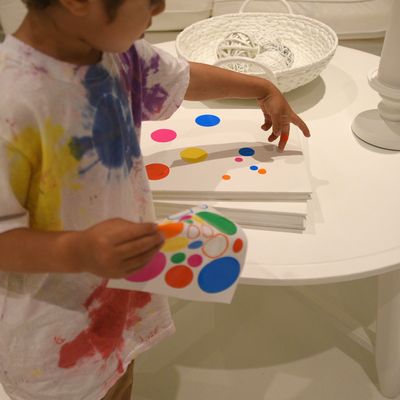
The other day, I happened to mention to a woman I’d just met, a respected former contemporary art gallerist, that I was taking my two daughters to the David Zwirner Gallery so they could have a turn stickering Yayoi Kusama’s The Obliteration Room with cheerfully bright polka dots. “Oh, I didn’t realize they were doing a kids’ project there!” she exclaimed.
Technically, of course, Zwirner isn’t hosting an after-school program, but one could easily be forgiven for mistaking the Kusama installation — an all-white replica of a living room and kitchen that viewers “paint” with multicolored sticker versions of the artist’s signature dots — for some sort of fun house.
Both Creative Time’s Drifting in Daylight in Central Park and the Public Art Fund’s Please Touch the Art in Brooklyn Bridge Park, spring’s most high-profile public art projects, also seem to be aimed squarely at children, so it felt fitting to bring along my daughters, Nina, 10, and Sascha, 7, both of them seasoned museumgoers and committed art-makers, to assess this month’s events.
We started with Kusama, where Nina methodically investigated the room, already heavily dotted, searching for stealth spots to leave her mark, such as on a page of one of the blank books or inside a lampshade. “I found the best hidden place,” she reported, after lifting the skirt of the sofa and sticking a tiny dot on the wooden frame. Together we stickered our initials on the baseboard under the kitchen cabinets.
Sascha, meanwhile, was understandably thrilled at the heretofore unheard-of prospect of being allowed to put stickers on anything she wanted, from furniture to appliances, walls, and even on top of other dots left by previous visitors. “We’re making art together,” she exclaimed, “and I don’t even know the other person!”
Herein lies the theoretical basis of many such art installations, sometimes described with the highfalutin term relational aesthetics: The idea is art as community-builder. Random International, the design collective behind 2013’s insanely popular “Rain Room” at the Museum of Modern Art, told me their goal was to bring people together in line — and on social media — as much as it was the technological feat of making the rain stop when sensors detect a human below. In his 2011 New Museum show, Carsten Höller invited visitors to strip down and float in his saltwater tank; several people I talked to then told me they did so because, well, other people were, and they dreaded the possibility of regret. FOMO is a big art motivator these days. Some of the work unabashedly rekindles grown-ups’ childhood memories of playground thrills, like Höller’s swooping 102-foot slide at the New Museum or Ann Hamilton’s 42 giant swings at the Park Avenue Armory in 2012. Perhaps adults have far too few opportunities for such sublime, wholesome fun.
Yet for many, the experience alone does not seem to satiate. It must be recorded — and shared. At Kusama, the adults tended to stick on a few dots, then tire of the exercise, which seemed for them tangential to the real reason they waited half an hour or more in line: the Instagram op. The dotted backdrop of choice was the western wall, in front of the faux TV, where the lighting seemed best. (Nina and Sascha were happy to use up their discarded sheets of dots.)
Photography, not so long ago almost universally banned by galleries and museums, has become not only tolerated but desperately encouraged by art institutions, for-profit and nonprofit alike. A decade ago, a veteran New York artist lamented to me that the director of a major museum gauged the success or failure of a show by attendance — he would cite the number of clicks the security guards registered for each exhibit that day. Now it seems acclaim is calculated by the number of tweets, Instagram postings, and likes. (We now live under the the tyranny of the all-important hashtag.)
If that is the measure, Jeppe Hein’s exhibition installed throughout Brooklyn Bridge Park will no doubt become a blockbuster. Please Touch the Art takes Instagram-pandering to a whole new level. Consider his series of vivid reddish-orange park benches, twisted and curved into whimsical shapes that invite children to climb them like jungle gyms. To be sure, Nina and Sascha particularly loved clambering up the one bent like an inverted V, then sliding down the other side. Hein cleverly placed one circular bench at an optimum spot right by the water, the Brooklyn Bridge and downtown Manhattan forming an irresistible backdrop beyond. Couples and families waited patiently in an informal line for their requisite photo ops.
Please Touch the Art is indisputably charming, happy, and fun. It’s also art-lite. Another element of the exhibit is a platform from which walls of water rise and fall intermittently. Who doesn’t like a good, cool soaking on a hot afternoon? Sascha attacked it with abandon. Scores of New York playgrounds feature water play, but, alas, it’s not socially acceptable for adults to partake. Here, grown-ups were free to get drenched alongside the squealing tikes. It was as if “Rain Room” had moved outside and dispensed with the illusion that the hoards lining up for hours to get inside didn’t actually want to get wet. Plenty of those I spoke to Sunday afternoon didn’t even realize the high-tech sprinklers were part of an art exhibit. Perhaps Hein missed his calling: He’d be a crackerjack playground designer.
Please Touch the Art is nothing if not a crowd-pleaser. From what we saw of Creative Time’s Drifting in Daylight, the group effort by eight artists is a mellower affair. We visited three of the projects: Alicia Framis’s mirrored globe with a slot to mail postcards to non-earthly residents, whatever that means to you; David Levine’s restaging of a brief scene from Bullets Over Broadway in a six-hour loop, which intrigued my daughters; and Spencer Finch’s solar-powered ice-cream truck. Finch has made some interesting work in the last few years incorporating natural phenomena and the senses, but the twin concepts behind this one — the heat of the sun fueling a machine to make a frozen treat, and coloring that ice cream with the hues from a watercolor of a Central Park sunset — felt a tad thin. Nina thought the truck, painted in sunset pastels, was pretty, and there were no complaints about the vanilla ice cream, which was smooth and pink. I’ll bet the ten-minute line was shorter than the one at Morgenstern’s, which was also doling out freebies Saturday afternoon. Still, it felt like Twitter bait.
The previous afternoon, after we left Kusama, we walked to Zwirner’s outpost on West 20th Street, where Richard Serra’s stacked steel cubes stood, majestic and unsettling. We circled them, marveling at the four distinct combinations, balanced yet scary, their mottled surfaces like mysterious abstract paintings. Nina mulled the title, Equal, in light of the fact that the cubes were neither all the same size nor in the same configurations. Save for a security guard and us, the room was empty. At the close of the weekend, Nina and Sascha wanted to see the pictures of themselves making sticker art and climbing the benches — yes, I snapped away. But it was those cubes they were talking about.




